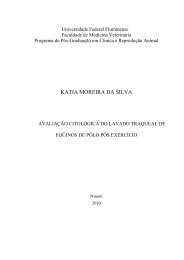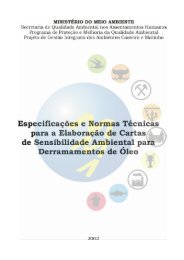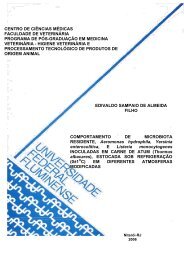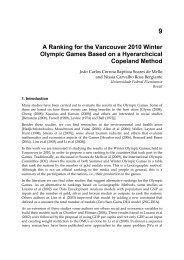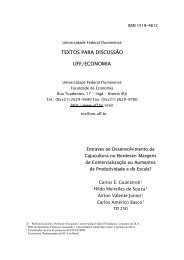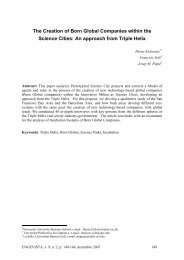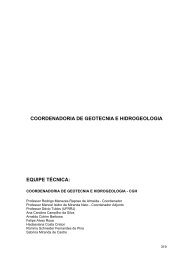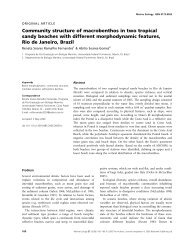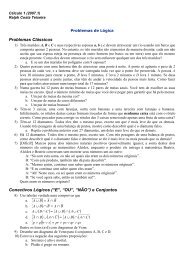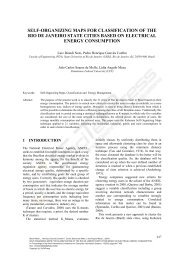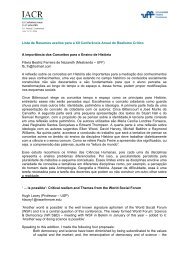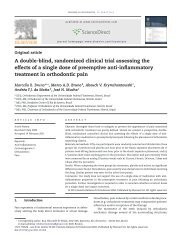Normal Torque of the Buccal Surface of Mandibular Teeth ... - SciELO
Normal Torque of the Buccal Surface of Mandibular Teeth ... - SciELO
Normal Torque of the Buccal Surface of Mandibular Teeth ... - SciELO
Create successful ePaper yourself
Turn your PDF publications into a flip-book with our unique Google optimized e-Paper software.
Braz Dent J (2006)17(2): 155-160<br />
<strong>Normal</strong> mandibular torque and bracket positioning ISSN 0103-6440 155<br />
<strong>Normal</strong> <strong>Torque</strong> <strong>of</strong> <strong>the</strong> <strong>Buccal</strong> <strong>Surface</strong> <strong>of</strong> <strong>Mandibular</strong><br />
<strong>Teeth</strong> and its Relationship with Bracket Positioning:<br />
A Study in <strong>Normal</strong> Occlusion<br />
Marcelo Antonio MESTRINER 1<br />
Carla ENOKI 1<br />
José Nelson MUCHA 2<br />
1 Faculty <strong>of</strong> Dentistry <strong>of</strong> Ribeirão Preto, University <strong>of</strong> São Paulo, Ribeirão Preto, SP, Brazil<br />
2 Department <strong>of</strong> Orthodontics, Faculty <strong>of</strong> Dentistry,<br />
Fluminense Federal University, NIterói, Rio de Janeiro, RJ, Brazil<br />
This study evaluated <strong>the</strong> degree <strong>of</strong> buccolingual inclination <strong>of</strong> mandibular tooth crowns relative to torque. For such purpose, mandibular<br />
and maxillary stone casts from 31 Caucasian Brazilian adults with normal occlusion, pleasant facial aspect and no history <strong>of</strong> previous<br />
orthodontic treatment were examined. A custom device was developed for measuring <strong>the</strong> degree <strong>of</strong> inclination (torque) <strong>of</strong> bracket slots<br />
<strong>of</strong> orthodontic appliances relative to <strong>the</strong> occlusion plane, at three bonding height: standard (center <strong>of</strong> clinical crown), occlusal (0.5 mm<br />
occlusally from standard) and cervical (0.5 mm cervically from standard). Except for <strong>the</strong> mandibular incisors, which presented a small<br />
difference in torque from one ano<strong>the</strong>r (lingual root torque for central incisors and buccal root torque for lateral incisors), <strong>the</strong> remaining<br />
average values are close to those found in <strong>the</strong> literature. Due to <strong>the</strong> convexity <strong>of</strong> <strong>the</strong> buccal surface, <strong>the</strong> 1-mm vertical shift <strong>of</strong> <strong>the</strong><br />
brackets from occlusal to cervical affected <strong>the</strong> values corresponding to <strong>the</strong> normal torque, in approximately 2 degrees in central and<br />
lateral incisors, 3 degrees in canines and 8 degrees in premolars and molars.<br />
Key Words: torque, mandibular teeth, buccolingual inclination, bracket slot.<br />
INTRODUCTION<br />
Despite several innovations incorporated to <strong>the</strong><br />
original “edgewise” system, its principles and applications<br />
remain essentially <strong>the</strong> same <strong>of</strong> those introduced by<br />
Angle (1) in 1928, when a rectangular wire was<br />
associated to a bracket with a rectangular slot, enabling<br />
three-dimensional movements.<br />
The force <strong>of</strong> <strong>the</strong> torque is probably <strong>the</strong> most<br />
important and powerful force produced by this<br />
mechanism (2). Its introduction in Orthodontics has<br />
enabled <strong>the</strong> control <strong>of</strong> dental movements in <strong>the</strong><br />
buccolingual direction, which has greatly widened <strong>the</strong><br />
possibilities <strong>of</strong> orthodontic treatment.<br />
The clinical parameter for assessing <strong>the</strong><br />
buccolingual inclination <strong>of</strong> each tooth is <strong>the</strong> angle<br />
formed by its buccal surface in relation to <strong>the</strong> occlusal<br />
plane (3-5). Because <strong>the</strong> orthodontist works mainly<br />
with dental crowns, <strong>the</strong>y should be <strong>the</strong> basis <strong>of</strong> <strong>the</strong><br />
communication or reference, in <strong>the</strong> same manner as<br />
<strong>the</strong>y are used as a clinical parameter for assessing <strong>the</strong><br />
treatment prognosis (6).<br />
Whenever conventional brackets are positioned<br />
on <strong>the</strong> buccal surface <strong>of</strong> <strong>the</strong> teeth <strong>of</strong> patients with<br />
normal occlusion, in predetermined heights, <strong>the</strong><br />
inclination <strong>of</strong> <strong>the</strong> bracket slot in relation to <strong>the</strong> occlusal<br />
plane indicates <strong>the</strong> amount <strong>of</strong> torque necessary to reach<br />
<strong>the</strong> ideal torque for <strong>the</strong> case.<br />
Regardless <strong>of</strong> <strong>the</strong> technique employed for malocclusion<br />
correction, in order to obtain a correct or<br />
normal buccolingual inclination, it is first necessary to<br />
know <strong>the</strong> average value and <strong>the</strong> variation limit <strong>of</strong><br />
Correspondence: Pr<strong>of</strong>. Marcelo Antonio Mestriner, Curso de Especialização em Ortodontia, Faculdade de Odontologia de Ribeirão Preto,<br />
Universidade de São Paulo, Avenida do Café, s/n Monte Alegre, 14040-904 Ribeirão Preto, SP, Brasil. Tel: +55-16-3602-3992. Fax: +55-<br />
16-3633-0999. e-mail: mestriner@previorto.com.br<br />
Braz Dent J 17(2) 2006
156 M.A. Mestriner et al.<br />
occlusions considered as clinically normal, in case <strong>the</strong><br />
orthodontist wishes to use this force in a rational and<br />
effective manner.<br />
The purpose <strong>of</strong> this study was to evaluate <strong>the</strong><br />
degree <strong>of</strong> buccolingual inclination <strong>of</strong> mandibular tooth<br />
crowns relative to torque.<br />
MATERIAL AND METHODS<br />
This study used 31 pairs <strong>of</strong> orthodontic stone<br />
casts obtained from Caucasian Brazilian adults (21<br />
females and 10 males) aged 17 years and 2 months to 30<br />
years (mean age 22 years and 1 month), who had never<br />
been submitted to orthodontic treatment.<br />
The following criteria were observed for selection<br />
<strong>of</strong> <strong>the</strong> individuals with normal occlusion; presence<br />
<strong>of</strong> all permanent teeth (third molar was not considered)<br />
(5,6); adequate anteroposterior relation <strong>of</strong> first molars<br />
and canines (5,7); slight curve <strong>of</strong> Spee (7); normal<br />
overbite and overjet (5,8); adequate buccolingual inclination<br />
<strong>of</strong> <strong>the</strong> tooth crowns (5,7); no restorations <strong>of</strong><br />
buccolingual surface and cusps (5); individuals would<br />
not benefit from <strong>the</strong> orthodontic <strong>the</strong>rapy in terms <strong>of</strong><br />
function, es<strong>the</strong>tics and stability (7).<br />
The method used in this study was <strong>the</strong> determination<br />
<strong>of</strong> <strong>the</strong> values, variations and means <strong>of</strong> <strong>the</strong><br />
inclination <strong>of</strong> <strong>the</strong> buccal surface <strong>of</strong> <strong>the</strong> mandibular teeth<br />
(in <strong>the</strong> mandibular casts), represented by <strong>the</strong> degree <strong>of</strong><br />
inclination (torque) <strong>of</strong> <strong>the</strong> bracket slot in relation to 3<br />
bonding heights (Fig. 1): standard (center <strong>of</strong> <strong>the</strong> clinical<br />
crown or Andrews LE-point) (3), cervical (0.5 mm<br />
cervically to <strong>the</strong> standard height) and occlusal (0.5 mm<br />
occlusally to <strong>the</strong> standard height).<br />
A longitudinal line parallel to <strong>the</strong> long axis <strong>of</strong> <strong>the</strong><br />
clinical crown (3) and a horizontal line that crossed it<br />
passing through Andrews LE-point (3) (determined<br />
with <strong>the</strong> aid <strong>of</strong> a compass) were drawn for all teeth (Fig.<br />
1). A single set <strong>of</strong> brackets (Unitek; 3M, St. Paul, MN,<br />
USA; standard edgewise dynalock 0.022 X 0.028 inches)<br />
was selected and used during <strong>the</strong> experimental phase.<br />
The brackets were bonded using sugar gum developed<br />
for indirect bonding technique.<br />
Special care was taken during trimming <strong>of</strong> <strong>the</strong><br />
stone casts in a way that <strong>the</strong> occlusal plane was<br />
maintained parallel to <strong>the</strong> base <strong>of</strong> <strong>the</strong> mandibular cast,<br />
and was determined with <strong>the</strong> aid <strong>of</strong> a custom<br />
parallelometer (Fig. 2). This device was developed to<br />
determine <strong>the</strong> degree <strong>of</strong> inclination <strong>of</strong> a specific point <strong>of</strong><br />
<strong>the</strong> buccal surface and measures <strong>the</strong> degree <strong>of</strong> inclination<br />
<strong>of</strong> <strong>the</strong> bracket slot in relation to <strong>the</strong> occlusal plane.<br />
For accurate assessment <strong>of</strong> <strong>the</strong> degree <strong>of</strong> inclination<br />
<strong>of</strong> <strong>the</strong> slot, a rectangular pointer was fabricated<br />
from 0.022 X 0.028 orthodontic wire. This pointer<br />
attached precisely to <strong>the</strong> brackets and transferred <strong>the</strong><br />
inclination from <strong>the</strong> horizontal plane to <strong>the</strong> vertical plane.<br />
A device was specially developed to accurately measure<br />
<strong>the</strong> degree <strong>of</strong> inclination (torque) <strong>of</strong> <strong>the</strong> vertical segment<br />
<strong>of</strong> <strong>the</strong> rectangular pointer (Fig. 3).<br />
The degree <strong>of</strong> inclination <strong>of</strong> <strong>the</strong> bracket slot was<br />
measured for each tooth in both mandibular hemiarches<br />
(right and left). Data were analyzed statistically by<br />
Student’s t-test at 5% significance level.<br />
Figure 1. Bonding heights. a: standard (center <strong>of</strong> clinical crown);<br />
b: cervical (0.5 mm cervically to <strong>the</strong> standard height); c: occlusal<br />
(0.5 mm occlusally to <strong>the</strong> standard height); d and e: vertical and<br />
horizontal reference lines, respectively.<br />
Figure 2. A: Determination <strong>of</strong> occlusal plane in <strong>the</strong> maxillary<br />
arch. 1 - Parallelometer; 2 - glass plaque; 3 - thin wax plate, 4 - 0.5<br />
mm propelling pencil. B: Transference <strong>of</strong> <strong>the</strong> occlusal plane to<br />
<strong>the</strong> mandibular cast. C: Orthodontic stone casts in centric relation.<br />
Braz Dent J 17(2) 2006
<strong>Normal</strong> mandibular torque and bracket positioning 157<br />
Figure 3. Stone cast positioned for measurement <strong>of</strong> <strong>the</strong> inclination<br />
<strong>of</strong> <strong>the</strong> vertical segment <strong>of</strong> <strong>the</strong> rectangular pointer after correct<br />
positioning <strong>of</strong> <strong>the</strong> protractor to eliminate <strong>the</strong> parallax effect.<br />
RESULTS AND DISCUSSION<br />
Table 1. Buccolingual degree <strong>of</strong> inclination (torque) <strong>of</strong> <strong>the</strong><br />
mandibular teeth.<br />
Standard Occlusal Cervical<br />
Central incisor 2 0 4<br />
Lateral incisor -2 -4 -1<br />
Canine -9 -11 -7<br />
1st premolar -16 -20 -12<br />
2nd premolar -22 -25 -17<br />
1st molar -27 -32 -23<br />
2nd molar -32 -36 -28<br />
The negative sign (-) indicates a buccal root torque and its<br />
absence indicates a lingual root torque.<br />
The results confirmed <strong>the</strong> reliability <strong>of</strong> <strong>the</strong> method<br />
used in this study. For <strong>the</strong> 3 bonding heights evaluated,<br />
no significant differences were observed among <strong>the</strong><br />
values obtained in <strong>the</strong> mandibular right and left hemiarches<br />
(p>0.05). Thus, to minimize <strong>the</strong> possibility <strong>of</strong> error on<br />
determination <strong>of</strong> <strong>the</strong> occlusal plane, <strong>the</strong> arithmetic<br />
averages <strong>of</strong> <strong>the</strong> values recorded in both hemiarches <strong>of</strong><br />
each stone cast were obtained and a final value was<br />
calculated for each tooth (Table 1).<br />
Determination and quantification <strong>of</strong> normal<br />
buccolingual inclinations <strong>of</strong> buccal surfaces <strong>of</strong> several<br />
teeth have been widely investigated (5,7,8,9-13). The<br />
major challenge has been <strong>the</strong> development <strong>of</strong> an adequate<br />
methodology that would be capable <strong>of</strong> yielding<br />
trustworthy values with direct clinical application (5).<br />
Questions regarding difficulties <strong>of</strong> <strong>the</strong>se studies<br />
may be summarized as follows: how to determine <strong>the</strong><br />
inclination <strong>of</strong> a surface which is mostly irregularly<br />
convex; if <strong>the</strong> degree <strong>of</strong> inclination is quantitatively<br />
represented by an angular value formed by <strong>the</strong> intersection<br />
<strong>of</strong> two lines, which linear references should be used<br />
for determining it; how to apply <strong>the</strong>se values clinically.<br />
Some answers have been proposed to <strong>the</strong>se three<br />
questions. First: buccal surface inclination (buccolingual)<br />
has been represented by a tangent vertical to this surface<br />
(first line <strong>of</strong> reference ) (5,8-11,13). For this tangent to<br />
represent values with clinical application, <strong>the</strong> chosen<br />
tangency point was <strong>the</strong> one each author considered as<br />
representative <strong>of</strong> <strong>the</strong> bracket location. In practical<br />
terms, <strong>the</strong> degree <strong>of</strong> inclination <strong>of</strong> <strong>the</strong> bracket slot<br />
represents <strong>the</strong> degree <strong>of</strong> inclination <strong>of</strong> this surface from<br />
<strong>the</strong> chosen point <strong>of</strong> tangency. In <strong>the</strong> present study, this<br />
was determined by <strong>the</strong> torque-indicating pointer. Second:<br />
two solutions have been proposed for determination<br />
<strong>of</strong> <strong>the</strong> second line <strong>of</strong> reference, namely a line<br />
perpendicular to <strong>the</strong> occlusal plane (5,7,8,13) or <strong>the</strong><br />
fixation plane <strong>of</strong> <strong>the</strong> brackets (10), and a line representing<br />
<strong>the</strong> long axis <strong>of</strong> ei<strong>the</strong>r <strong>the</strong> tooth (8) or <strong>the</strong> clinical<br />
crown (9,11). The latter does not present a direct<br />
clinical application because it only considers dental<br />
anatomy without taking into account its relationship<br />
with normal occlusion, as well as tooth relationship with<br />
<strong>the</strong> face. Third: <strong>the</strong> angular values obtained are considered<br />
as <strong>the</strong> amount <strong>of</strong> torsion that <strong>the</strong> wire should have<br />
or compensation that <strong>the</strong> brackets should present to<br />
produce an ideal force (ideal torque) capable <strong>of</strong> determining<br />
a normal buccolingual positioning <strong>of</strong> tooth crowns.<br />
The force <strong>of</strong> <strong>the</strong> torque may be produced by<br />
means <strong>of</strong> torsion carried out with a rectangular wire or<br />
by means <strong>of</strong> compensation incorporated to <strong>the</strong> brackets,<br />
which never<strong>the</strong>less appears only when <strong>the</strong> rectangular<br />
wire suffers an elastic deformation, as it is attached to<br />
<strong>the</strong> bracket. Its trend to return to <strong>the</strong> original form<br />
results in <strong>the</strong> creation <strong>of</strong> a binary situation capable <strong>of</strong><br />
altering <strong>the</strong> buccolingual inclination <strong>of</strong> <strong>the</strong> tooth.<br />
Whenever <strong>the</strong>se procedures (torsion <strong>of</strong> <strong>the</strong> wire or<br />
compensation in <strong>the</strong> brackets) are performed to produce<br />
forces that determine a normal buccolingual inclination<br />
<strong>of</strong> <strong>the</strong> teeth, <strong>the</strong>y are referred to as an ideal torque.<br />
Never<strong>the</strong>less, since <strong>the</strong> force <strong>of</strong> <strong>the</strong> torque aims<br />
at establishing a normal buccolingual inclination, it is not<br />
Braz Dent J 17(2) 2006
123456789012345678901234567890121234567890123456789012345678901212345<br />
123456789012345678901234567890121234567890123456789012345678901212345<br />
123456789012345678901234567890121234567890123456789012345678901212345<br />
123456789012345678901234567890121234567890123456789012345678901212345<br />
123456789012345678901234567890121234567890123456789012345678901212345<br />
123456789012345678901234567890121234567890123456789012345678901212345<br />
123456789012345678901234567890121234567890123456789012345678901212345<br />
123456789012345678901234567890121234567890123456789012345678901212345<br />
123456789012345678901234567890121234567890123456789012345678901212345<br />
123456789012345678901234567890121234567890123456789012345678901212345<br />
123456789012345678901234567890121234567890123456789012345678901212345<br />
123456789012345678901234567890121234567890123456789012345678901212345<br />
123456789012345678901234567890121234567890123456789012345678901212345<br />
123456789012345678901234567890121234567890123456789012345678901212345<br />
123456789012345678901234567890121234567890123456789012345678901212345<br />
123456789012345678901234567890121234567890123456789012345678901212345<br />
123456789012345678901234567890121234567890123456789012345678901212345<br />
123456789012345678901234567890121234567890123456789012345678901212345<br />
123456789012345678901234567890121234567890123456789012345678901212345<br />
123456789012345678901234567890121234567890123456789012345678901212345<br />
123456789012345678901234567890121234567890123456789012345678901212345<br />
123456789012345678901234567890121234567890123456789012345678901212345<br />
123456789012345678901234567890121234567890123456789012345678901212345<br />
123456789012345678901234567890121234567890123456789012345678901212345<br />
123456789012345678901234567890121234567890123456789012345678901212345<br />
123456789012345678901234567890121234567890123456789012345678901212345<br />
123456789012345678901234567890121234567890123456789012345678901212345<br />
123456789012345678901234567890121234567890123456789012345678901212345<br />
123456789012345678901234567890121234567890123456789012345678901212345<br />
123456789012345678901234567890121234567890123456789012345678901212345<br />
123456789012345678901234567890121234567890123456789012345678901212345<br />
123456789012345678901234567890121234567890123456789012345678901212345<br />
123456789012345678901234567890121234567890123456789012345678901212345<br />
123456789012345678901234567890121234567890123456789012345678901212345<br />
123456789012345678901234567890121234567890123456789012345678901212345<br />
123456789012345678901234567890121234567890123456789012345678901212345<br />
123456789012345678901234567890121234567890123456789012345678901212345<br />
123456789012345678901234567890121234567890123456789012345678901212345<br />
123456789012345678901234567890121234567890123456789012345678901212345<br />
123456789012345678901234567890121234567890123456789012345678901212345<br />
123456789012345678901234567890121234567890123456789012345678901212345<br />
123456789012345678901234567890121234567890123456789012345678901212345<br />
123456789012345678901234567890121234567890123456789012345678901212345<br />
123456789012345678901234567890121234567890123456789012345678901212345<br />
123456789012345678901234567890121234567890123456789012345678901212345<br />
123456789012345678901234567890121234567890123456789012345678901212345<br />
123456789012345678901234567890121234567890123456789012345678901212345<br />
123456789012345678901234567890121234567890123456789012345678901212345<br />
123456789012345678901234567890121234567890123456789012345678901212345<br />
123456789012345678901234567890121234567890123456789012345678901212345<br />
123456789012345678901234567890121234567890123456789012345678901212345<br />
123456789012345678901234567890121234567890123456789012345678901212345<br />
158 M.A. Mestriner et al.<br />
uncommon to use <strong>the</strong> term “ideal torque” to designate<br />
<strong>the</strong> normal buccolingual inclination <strong>of</strong> <strong>the</strong> teeth, as for<br />
example: "<strong>the</strong> ideal torque <strong>of</strong> <strong>the</strong> upper central incisor is<br />
<strong>of</strong> 4 degrees", which means that <strong>the</strong> torsion <strong>of</strong> <strong>the</strong><br />
rectangular wire or <strong>the</strong> corresponding compensation<br />
incorporated to <strong>the</strong> bracket should be <strong>of</strong> 4 degrees so<br />
that this tooth might be positioned with a normal<br />
buccolingual inclination. In <strong>the</strong> present study, <strong>the</strong> term<br />
torque was used to designate both such compensation<br />
(incorporated to <strong>the</strong> wire or to <strong>the</strong> brackets) and <strong>the</strong><br />
normal buccolingual inclinations <strong>of</strong> <strong>the</strong> teeth.<br />
Regarding <strong>the</strong> mandibular incisors, <strong>the</strong> normal<br />
torque suggested by <strong>the</strong> several authors ranges from<br />
degree 0 (8,14) to 1 (buccal root torque) (15), indicating<br />
<strong>the</strong> vertical position <strong>of</strong> <strong>the</strong>se teeth.<br />
Currently, it is a consensus that <strong>the</strong> mandibular<br />
central and lateral incisors have <strong>the</strong> same torque. Never<strong>the</strong>less,<br />
it has been demonstrated that <strong>the</strong>re is a small<br />
variation between <strong>the</strong> torque <strong>of</strong> <strong>the</strong>se two teeth (5,10,13)<br />
(Table 2). This study showed a difference <strong>of</strong> at least 4<br />
degrees between <strong>the</strong> torque <strong>of</strong> <strong>the</strong> mandibular central<br />
and lateral incisors, independently <strong>of</strong> <strong>the</strong> bonding height<br />
(Table 1). In view <strong>of</strong> <strong>the</strong> values obtained, it could have<br />
been mistakenly stated that <strong>the</strong> mandibular lateral incisor<br />
(buccal root torque) is more vertical than <strong>the</strong> mandibular<br />
central incisor (lingual root torque).<br />
The fact that <strong>the</strong> lateral incisor presents a buccal<br />
root torque in relation to <strong>the</strong> lateral incisor for <strong>the</strong> same<br />
bonding height simply reflects an anatomical difference<br />
<strong>of</strong> <strong>the</strong> buccal surface. It would also be incorrect to<br />
assume that <strong>the</strong> root <strong>of</strong> <strong>the</strong> lateral incisor is more in<br />
buccoversion than <strong>the</strong> central incisor because <strong>the</strong>re are<br />
factors such as <strong>the</strong> variations between <strong>the</strong> angle formed<br />
by <strong>the</strong> crown and <strong>the</strong> root (9).<br />
Although this conclusion could cause surprise,<br />
its explanation is quite simple. The buccolingual diameter<br />
<strong>of</strong> <strong>the</strong> mandibular lateral incisor is slightly greater than<br />
that <strong>of</strong> <strong>the</strong> mandibular central incisor (0.4 mm on<br />
average) (16-17). This anatomical difference leads <strong>the</strong><br />
tangent <strong>of</strong> <strong>the</strong> buccal surface <strong>of</strong> <strong>the</strong> lateral incisor to<br />
assume a more vertical position compared to that <strong>of</strong> <strong>the</strong><br />
central incisor (Fig. 4).<br />
<strong>Buccal</strong> root torque considered as being progressive<br />
to <strong>the</strong> mandibular posterior teeth from <strong>the</strong> canines<br />
(5,18) was confirmed in this study, regardless <strong>of</strong> <strong>the</strong><br />
bonding height (Table 1). This increase was expressed<br />
in a more uniform manner in <strong>the</strong> cervical heght, where<br />
it was observed an arithmetic progression with an<br />
Figure 4. Lateral view <strong>of</strong> <strong>the</strong> stone cast showing a 9 degreedifference<br />
between central and lateral incisors and lateral incisor<br />
and canine. Progressive torque starts from <strong>the</strong> central incisors.<br />
Table 2. <strong>Torque</strong> means (± SD) reported by different authors in comparison to those found in <strong>the</strong> present study.<br />
Vardimon* (13) Vardimon**(13) Dellinger***(10) Uður*(5) This study*<br />
Central incisor 1.26 ± 5.41 2.24 ± 5.91 -0.80 ± 4.32 0.92 ± 6.01 2.03 ± 5.30<br />
Lateral incisor -1.35 ± 5.10 -0.90 ± 6.00 -2.80 ± 5.01 -3.05 ± 5.23 -2.34 ± 4.70<br />
Canine -9.00 ± 3.77 -9.69 ± 4.43 -12.70 ± 4.51 -11.35 ± 5.02 -8.90 ± 4.92<br />
1st premolar -15.90 ± 4.36 -16.40 ± 5.34 -18.60 ± 5.66 -20.32 ± 5.52 -16.42 ± 5.46<br />
2nd premolar -21.16 ± 5.15 -22.53 ± 6.04 -22.48 ± 5.17 -26.50 ± 5.12 -21.57 ± 6.09<br />
1st molar -26.00 ± 4.60 -26.89 ± 5.48 -29.60 ± 6.82 -34.15 ± 3.79 -27.45 ± 8.04<br />
2nd molar -32.82 ± 4.92 -36.41 ± 7.39 -30.46 ± 6.84 ----- -31.70 ± 7.18<br />
* = <strong>Normal</strong> occlusion, without orthodontic treatment; ** = <strong>Normal</strong> occlusion and set-ups without extraction; *** = Set-ups with and<br />
without extractions. <strong>Torque</strong> means presented as <strong>the</strong> findings <strong>of</strong> this study (last column) correspond to <strong>the</strong> standard bonding height.<br />
Braz Dent J 17(2) 2006
<strong>Normal</strong> mandibular torque and bracket positioning 159<br />
increment <strong>of</strong> approximately 5 degrees for adjacent<br />
teeth. This characteristic actually started to be observed<br />
from <strong>the</strong> mandibular central incisor and not only from<br />
<strong>the</strong> canine, denoting a progressive torque in <strong>the</strong> whole<br />
mandibular arch from anterior to posterior (Table 1 and<br />
Fig. 4). This is in agreement with <strong>the</strong> findings <strong>of</strong><br />
previous studies (5,10,13) (Table 2). The importance <strong>of</strong><br />
knowing <strong>the</strong> average torque for each tooth is still<br />
unclear. Its major applicability is to be used as an initial<br />
reference point for maintenance or correction <strong>of</strong> <strong>the</strong><br />
axial inclination (buccolingual) <strong>of</strong> <strong>the</strong> teeth.<br />
The values in Table 3 reflect more accurate data,<br />
obtained by means <strong>of</strong> a more consistent sample and<br />
techniques. We can notice a great similarity between <strong>the</strong><br />
values obtained in <strong>the</strong>se studies and <strong>the</strong> present work.<br />
Vardimon (13), Dellinger (10) and Ugur (5) have<br />
also found differences in torque between <strong>the</strong> central and<br />
lateral mandibular incisors, respectively: 2.61 and 3.14,<br />
3.60 and 3.97 degrees. Never<strong>the</strong>less, <strong>the</strong>se differences<br />
were slightly greater in <strong>the</strong> present work: 4.01 occlusal,<br />
4.37 standard and 4.58 cervical (Table 1). This might be<br />
attributed to two factors: <strong>the</strong> slight crowding <strong>of</strong> <strong>the</strong><br />
mandibular incisors observed in <strong>the</strong> studied populations<br />
and morphological differences in dental anatomy inherent<br />
to <strong>the</strong> distinct ethnic groups evaluated. The slight<br />
anteroinferior crowding is not consistent with <strong>the</strong> findings<br />
by Vardimon (13), who reporetd a 2.61-degree<br />
difference in torque for teeth <strong>of</strong> orthodontic patients<br />
with normal occlusion and a 3.14-degree difference<br />
when <strong>the</strong>y are associated to set-up (Table 2). Difference<br />
in torque should decrease when <strong>the</strong> group is associated<br />
with set-up (<strong>the</strong>oretically without anteroinferior crowding)<br />
with <strong>the</strong> normal occlusion group (where up to 1 mm<br />
crowding was allowed). Morphological differences in<br />
dental anatomy find some support because <strong>the</strong> difference<br />
<strong>of</strong> buccolingual diameter between <strong>the</strong> mandibular<br />
incisors suffers considerable variations (from 0.1 to 0.4<br />
mm) depending on <strong>the</strong> sample studied (16,17).<br />
The normal variation limit, represented by <strong>the</strong><br />
standard deviation <strong>of</strong> <strong>the</strong> buccolingual inclination, tends<br />
to increase from mesial to distal, being approximately 5<br />
degrees for mandibular incisors and canines, 6 degrees<br />
for premolars and 7 degrees for molars (Table 2).<br />
Never<strong>the</strong>less, <strong>the</strong> most significant information is perhaps<br />
<strong>the</strong> great variation found in <strong>the</strong> normal occlusion<br />
sample. Even if this is a sample constituted by a selected<br />
and rare group <strong>of</strong> individuals, <strong>the</strong> torque <strong>of</strong> incisors and<br />
canines, for example, ranged from negative (buccal<br />
root torque) to positive values (lingual root torque).<br />
Table 3 illustrates <strong>the</strong> mean torque variations<br />
between <strong>the</strong> occlusal and cervical bonding heights (total<br />
variation <strong>of</strong> 1 mm). These variations only reflect buccal<br />
surface anatomy, not being influenced by <strong>the</strong> degree <strong>of</strong><br />
buccolingual inclination <strong>of</strong> <strong>the</strong> tooth as a whole (Fig. 5).<br />
The approximate average <strong>of</strong> <strong>the</strong> torque variation between<br />
<strong>the</strong> bonding extremes (Table 3) revealed that <strong>the</strong><br />
mandibular incisors and canines present a slightly<br />
convex surface (3 and 4 degrees respectively) compared<br />
to mandibular premolars and molars (8 degrees).<br />
This variation may be even larger clinically because<br />
factors such as adaptation <strong>of</strong> bands and brackets,<br />
welding <strong>of</strong> <strong>the</strong> brackets and <strong>the</strong>ir cementation or bonding<br />
may also contribute to a higher degree <strong>of</strong> variation.<br />
For any type <strong>of</strong> fixed appliance, care must be<br />
taken regarding <strong>the</strong> correct positioning <strong>of</strong> <strong>the</strong> brackets<br />
and tubes. This is crucial for straight arch techniques<br />
because it can affect <strong>the</strong> amount <strong>of</strong> torque transmitted<br />
to <strong>the</strong> tooth (3,9,10-12). Orthodontists must be aware<br />
Table 3. Differences between <strong>the</strong> buccolingual degrees <strong>of</strong><br />
inclination (torque) <strong>of</strong> <strong>the</strong> mandibular teeth recorded at <strong>the</strong> occlusal<br />
and cervical bonding heights.<br />
Means (± SD) Maximum Minimum<br />
Central incisor 3.34 ± 1.55 7.63 0.75<br />
Lateral incisor 2.77 ± 1.45 5.50 0.50<br />
Canine 3.75 ± 1.89 9.75 8.88<br />
1st premolar 7.73 ± 2.39 14.63 4.25<br />
2nd premolar 8.41 ± 2.68 14.88 4.38<br />
1st molar 8.44 ± 2.45 13.13 3.63<br />
2nd molar 7.70 ± 2.78 12.88 1.25<br />
Figure 5. <strong>Torque</strong> variation according to buccal surface anatomy.<br />
Braz Dent J 17(2) 2006
160 M.A. Mestriner et al.<br />
that <strong>the</strong>y are treating individuals and not statistical data<br />
and thus <strong>the</strong> amplitude <strong>of</strong> sample variation is clinically<br />
more significant than its standard deviation.<br />
The following conclusions may de drawn: 1 -<br />
Except for <strong>the</strong> mandibular incisors, which had a small<br />
difference in torque from each o<strong>the</strong>r (lingual root torque<br />
for central incisors and buccal root torque for lateral<br />
incisors), <strong>the</strong> o<strong>the</strong>r values were close to those found in<br />
<strong>the</strong> literature. 2 - <strong>Torque</strong> increased progressively in <strong>the</strong><br />
three bonding heights for <strong>the</strong> mandibular central incisors,<br />
but <strong>the</strong> cervical height showed a more uniform<br />
pattern, with an average increase <strong>of</strong> nearly 5 degrees for<br />
adjacent teeth. 3 - The vertical shift <strong>of</strong> orthodontic<br />
brackets, from occlusal to cervical, affected normal<br />
torque values as follows: a) torque <strong>of</strong> mandibular<br />
incisors tended towards positive values (lingual root<br />
torque), as <strong>the</strong> bracket shifted from occlusal to cervical;<br />
b) torque <strong>of</strong> posterior teeth tended towards negative<br />
values (buccal root torque) at cervical heights compared<br />
to occlusal heights; c) <strong>the</strong> more cervical <strong>the</strong><br />
position <strong>of</strong> <strong>the</strong> orthodontic appliance, <strong>the</strong> lesser <strong>the</strong> need<br />
for buccal root torque application. 4 - Average variations<br />
between <strong>the</strong> bonding extremes, i.e., occlusal and<br />
cervical, were: a) central and lateral incisors: approximately<br />
2 degrees; b) canines: approximately 3 degrees;<br />
c) premolars and molars: approximately 8 degrees.<br />
RESUMO<br />
Este estudo avaliou o grau de inclinação vestíbulo-lingual de<br />
coroas dentais de dentes inferiores em relação ao torque. Foram<br />
obtidos modelos de gesso das arcadas superiores e inferiores de<br />
31 adultos brasileiros, brancos com oclusão normal e estética<br />
facial agradável, que nunca haviam sido submetidos a tratamento<br />
ortodôntico. Foi desenvolvido um dispositivo capaz de medir o<br />
grau de inclinação do encaixe retangular do bráquete em relação ao<br />
plano oclusal, em três alturas de colagem: padrão (centro da coroa<br />
clínica); oclusal (deslocado 0.5 mm para oclusal em relação à<br />
posição padrão) e cervical (0.5 mm para cervical em relação à<br />
posição padrão). Com exceção dos incisivos inferiores, que<br />
apresentaram pequena diferença de torque entre si (centrais com<br />
torque lingual de raiz e laterais com torque vestibular de raiz), os<br />
demais valores médios estão próximos aos encontrados na<br />
literatura. A variação vertical dos bráquetes em 1.0 mm (de<br />
oclusal para cervical) determinou, devido à convexidade da face<br />
vestibular, pequenas variações de torque para incisivos e caninos<br />
e valores mais acentuados para pré-molares e molares (em média<br />
2, 3 e 8 graus, respectivamente).<br />
ACKNOWLEDGEMENTS<br />
This research was part <strong>of</strong> <strong>the</strong> requirements to grant a Master’s<br />
degree in dentistry from <strong>the</strong> Postgraduate Program in Orthodontics<br />
<strong>of</strong> <strong>the</strong> Faculty <strong>of</strong> Dentistry <strong>of</strong> <strong>the</strong> Federal University <strong>of</strong> Rio<br />
de Janeiro (UFRJ) and was supported by CAPES.<br />
REFERENCES<br />
1 . Angle EH. The latest and best in orthodontic mechanism.<br />
Dent Cosmos 1928;70:1143-1158.<br />
2 . Kang BS, Baek SH, Mah J, Yang WS. Three-dimensional<br />
relationship between <strong>the</strong> critical contact angle and <strong>the</strong><br />
torque angle. Am J Orthod Dent<strong>of</strong>ac Orthop 2003;123:64-<br />
73.<br />
3 . Andrews LF. The straight-wire appliance explained and compared.<br />
J Clin Orthod 1976;10:174-195.<br />
4 . Ross VA, Isaacson RJ, Germane N, Rubenstein LK. Influence<br />
<strong>of</strong> vertical growth pattern on faciolingual inclination and<br />
treatment mechanics. Am J Orthod Dent<strong>of</strong>ac Orthop<br />
1990;98:422-429.<br />
5 . Uður T, Yukay F. <strong>Normal</strong> faciolingual inclinations <strong>of</strong> tooth<br />
crowns compared with treatment groups <strong>of</strong> standard and<br />
pretorgued brackets. Am J Orthod Dent<strong>of</strong>ac Orthop<br />
1997;112:50-57.<br />
6 . Peck S, Peck H. Crown dimensions and mandibular incisor<br />
alignment. Angle Orthod 1972;42:149-153.<br />
7 . Andrews LF. The six keys to normal occlusion. Am J Orthod<br />
1972;62:296-309.<br />
8 . Ricketts RM. Provocations and perceptions in crani<strong>of</strong>acial<br />
orthopedics. Denver: Rocky Mountain Orthodontics; 1989.<br />
9 . Bryant RM, Sadowsky PL, Dent M, Hazelrig JB. Variability in<br />
three morphologic features <strong>of</strong> <strong>the</strong> permanent maxillary central<br />
incisor. Am J Orthod 1984;86:25-32.<br />
10. Dellinger EL. A scientific assessment <strong>of</strong> <strong>the</strong> straight-wire<br />
appliance. Am J Orthod 1978;73:290-299.<br />
11. Germane N, Bentley BE, Isaacson RJ. Three biologic variables<br />
modifying faciolingual tooth angulation by straight-wire appliances.<br />
Am J Orthod Dent<strong>of</strong>ac Orthop 1989;96:312-319.<br />
12. Germane N, Bentley BE, Isaacson RJ. The morphology <strong>of</strong><br />
cuspids in relation to preadjusted appliances. Angle Orthod<br />
1990;60:49-54.<br />
13. Vardimon AD, Lambertz W. Statistical evaluation <strong>of</strong> torque<br />
angles in reference to straight-wire appliance (SWA) <strong>the</strong>ories.<br />
Am J Orthod 1986;89:56-66.<br />
14. Hocevar RA. Begg-edgewise diagnosis-determined totally individualized<br />
orthodontic technique: foundations, description,<br />
and rationale. Am J Orthod 1985;88:31-46.<br />
15. Miethke RR. Third order tooth movements with straight<br />
wire appliances. Influence <strong>of</strong> vestibular tooth crown morphology<br />
in <strong>the</strong> vertical plane. J Or<strong>of</strong>ac Orthop 1997;<br />
58:186-197.<br />
16. Bishara SE, Jakobsen JR, Abdallah EM, Garcia AF. Comparisons<br />
<strong>of</strong> mesiodistal and buccolingual crown dimensions <strong>of</strong> <strong>the</strong><br />
permanent teeth in three populations from Egypt, Mexico<br />
and <strong>the</strong> United States. Am J Orthod Dent<strong>of</strong>ac Orthop<br />
1989;96:416-422.<br />
17. Smith RJ, Davidson WM, Gipe DP. Incisors shape and incisors<br />
crowding: a re-evaluation <strong>of</strong> <strong>the</strong> Peck and Peck ratio. Am J<br />
Orthod 1982;83:231-235.<br />
18. Roth RH. The straight-wire appliance 17 years later. J Clin<br />
Orthod 1987;21:632-642.<br />
Accepted October 13, 2005<br />
Braz Dent J 17(2) 2006



